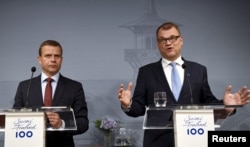Finns voted on Sunday in a general election in which widespread public dissatisfaction with recent spending cuts looked likely to propel the opposition Social Democratic Party back to government for the first time in 16 years.
The left-wing party leads Finland's two main opinion polls with about 19 percent of the vote, having campaigned against the austerity policies of Center Party Prime Minister Juha Sipila and his Finance Minister Petteri Orpo — leader of the conservative National Coalition Party.
But the far-right Finns Party, led by hardline MEP Jussi Halla-aho, has seen a surge in support in recent months during an anti-immigration dominated campaign, urging people to "Vote for some borders."
Polls show the Finns Party ending up in second or third place, meaning it could hold significant influence in the talks to form the next government, which in Finland is typically a coalition of three or four parties.
The current center-right government, elected in 2015, promised to rebalance the nation's economy after a prolonged slump with a program of deep spending reductions.
However, cuts to Finland's prized education system, and a tightening of unemployment benefit criteria, provoked loud and widespread public opposition.
Casting her vote shortly after polling stations opened at 9:00 am (0600 GMT), a Helsinki resident who gave her name as Jenny said that she had only settled on who to vote for at the last minute.
"There have been a lot of cuts and some, like education, in areas they promised they wouldn't cut. Of course, the parties from the last government are going to suffer because of that now," she told AFP.
Another voter, Katja Katajamaki, told AFP she felt the government's austerity had gone "too far in some ways".
"I don't think that you just fix the situation with spending cuts," she said.
Petteri Orpo, leader of the conservative National Coalition Party and co-architect of the government's savings program, has denounced the Social Democratic Party's anti-austerity plans as "irresponsible".
However, in a tacit acknowledgement that the public mood has turned against further belt-tightening, Orpo has insisted the economy is now strong enough to allow for some more generous public spending.
A record 1.5 million Finns, over a third of the electorate, had already cast their ballots during a week of advance voting earlier this month.
Populist surge
Opinion polls suggest the Social Democrats' lead has narrowed in recent weeks to as little as two points, ahead of the National Coalition and Finns Party which are battling it out for second place.
Some have blamed the shrinking lead on the inability of party leader Antti Rinne, a 56-year-old former trade union boss, to attract large numbers of new, younger voters.
The growing Finns Party ratings, on the other hand, appear to be driven by new supporters who have not voted in the past.
The Finns Party has run a vocal campaign calling for asylum-based immigration to be reduced to almost zero, and decrying the "climate hysteria" of other parties seeking action against global warming.
At a Finns Party rally on the eve of the vote in Myyrmaki, a disadvantaged suburb of the capital, a crowd of people, young and old, clamored around party leader Jussi Halla-aho, asking for autographs and congratulating him on the campaign.
"You will be the next prime minister," one woman assured him.
Forecasts suggest no party is likely to draw more than 20 percent of the vote, meaning the result could be historically close.
This could make the negotiations to build a government coalition particularly tricky.
The major parties have all expressed strong reservations about joining a government with the Finns Party, whose policies lurched to the right after Halla-aho became leader in 2017.
Ageing population pressure
Finland has a rapidly ageing population and declining birth rate, and the question of how to keep funding the country's generous welfare state has been a key election battleground.
Yet the Social Democratic Party may face tough economic conditions in which to implement its anti-austerity promises: many economic forecasts suggest Finland's GDP growth will slow in the coming years.
Immigration became a hot election topic despite Finland being western Europe's most homogeneous country with a foreign-born population of just 6.6 percent.
In January, outrage over highly publicized reports of an alleged string of sexual assaults by immigrant men boosted support for the Finns Party's anti-immigration agenda.
Polls close at 8:00 p.m. (1700 GMT), with all votes provisionally counted by 9:45 p.m. (1845 GMT).







